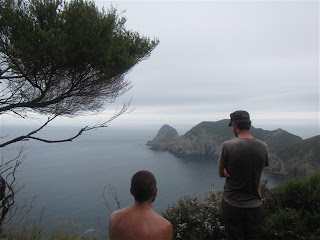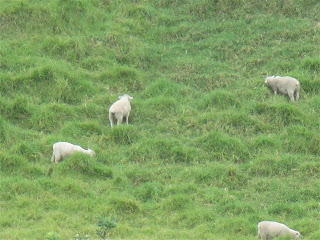The morning after we arrived in
Urupukapuka, we piled into Tuerto and motored just over a mile across
the channel to the mainland, landing on a beach at a town called
Rawiki ('w' pronounced 'v') and joking that that had been our most
dangerous crossing, though Tuerto was doing well since his latest
patch and only suffered a few slow leaks. We pulled the dinghy up,
tied the painter to a tree and walked up to the road. There were a
few houses lining the road at the base of the small cove, but nothing
stirred. Up the street, we saw a man with a hard-hat walk past a
fence toward a house with scaffolding on the front. We walked up and
asked one of the construction workers if he knew where to find the
trail to Cape Brett. He said, “Oh,” and got slowly up from
kneeling. He walked towards us wiping his gloved hands together
contemplatively and we all had the feeling he was about to describe
whatever long, winding journey to the trail-head to which we had
subjected ourselves.
 |
| Our boats anchored off the beach at center-right. |
“Well,” he pointed along the road
to our right, “you walk up the road that way about fifty-yards and
there's some stairs. That's the start of the trail.”
“Oh, alright, guess we should have
explored a bit more. Thanks. Take 'er easy.”
“Sure thing.”
 |
| The Kleemans along the path. |
At the base of the stairs I sat down
and put my boots on. It had been a long time since I had worn my
hiking boots and wool socks with them, but in a few hours, I would be
very glad to have them. The trail on which we set out was immediately
challenging. We had estimated from a map that it was about 10 km each
way to Cape Brett, which forms the southern limit of Bay of Islands.
We weren't too far off, though it ended up coming out to about 16 km
each way. The real kicker, though, was the elevation changes. The
ridge that formed the Cape was long and vertically winding. We all
quickly realized what sort of physical condition we were in. It
wasn't so much the cardiovascular aspect of things, but the climbs.
Oh, there were many steep climbs. The most heart-breaking part was
knowing that it would be no less demanding on the return trip.
Nevertheless, we pushed on and made it to the furthest peak. We could
have followed the trail down toward the water where there was
apparently a DOC cabin, but we didn't have the time if we were going
to get back in daylight. We ate lunch and rested. The coast was
remarkable from that spot, the ocean in a state of quiet beauty. The
clouds had been converging and descending, though, and it dawned on
us in a mildly serious manner that we were facing our already
exhausted bodies with another six hours of grueling hiking with the
threat of rain and darkness. Our quadriceps had been wobbly at the
end of the out-trip, so we figured the way back would be slower. We
estimated arriving to Tuerto at about twenty-two-hundred hours and we
joked at the irony of having sailed across the Pacific on little
sailboats to die of hypothermia on a day hike. It was indeed
difficult, at times painful, but we actually made really good time
and managed to get it all the way back to Tuerto, drink hot chocolate
from the Kleeman's camp stove and dinghy back to the boats before
dark.
 |
| Alex naps at the peak. |
In spite of the physical over-exertion,
it was an amazing hike. The trail was beautiful, laden with forests
and shrubs and small swaths of grasslands. The views, when available
from certain perches and points, were stunning of little untouched
beaches and remote coves, cliffs with myriad birds whose cries seemed
to carry for miles and miles, and the Pacific. Still there,
unconquered, abiding, graciously accommodating some of our friends.
It's hard to look out at the Ocean and
consider being through, even if only for now. I've run through just
about every scenario for what to do at this stage and at one time or
another pledged allegiance to each of them. I was close to putting
Ardea on the market even before I arrived. Take what I can get for
her and move on. Then I thought I'd like to have some time to sail
here, especially with my brother coming for a visit. So I put it off
thinking I could put her on the market when I got here and see what
happens, as it's unlikely to unfold quickly. But then, what if it
does? Could I give her up? What price can you put on this? She's beat
up. It's been a long ride. She needs bottom paint and deck work and
some new timbers to support the masts. Who would I be if I sold her
in this condition? Like most, I cringe at the thought of someone
taking her in planning to fix her up but then letting her crumble
away. (You can't do that! That's my boat!--Not any more.) In some
ways, though, she'll always be my boat.
There's a great deal of talk nowadays
about what the hell next? Nobody seems to have it figured out all the
way. A lot of us talk about the possibility of selling our boats-
“getting out”- but we try not to talk like that in front of them.
The boats, that is. They're alive, you know? Moitessier was right
about that. We all know how much time and effort and money goes into
them. But we love them in a very powerful way. We love what they
represent and the freedom they bring. We are drawn to the
satisfaction of passage-making, to the oneness with the sea. We can
be drawn away in our minds, though, from those things. Especially if
we focus on the list. The goddamned list. We talk about it with
disdain all the time, we scorn the cycle of maintenance. Fix one
thing and another breaks. Equipment always in a state of flux.
Something always on the way in, something always on the way out.
Never. Ending. I watch the cabin roof under the main-mast step
leaking water in the rain, the compression getting worse over the
last three-thousand ocean miles. It wears on my mind and sometimes I
want out. We all get this way.
Then we think about what it would be
like to go back to life-without-a-boat. What would we do with our
time? How would we get around? Where would we live? Would we stop
always watching the weather? Would we lose touch? Because right now
the environment is us and our boat and the sea and the sky. There are
no dividing lines, it is all one and the same. We have learned to
melt into nature, not trod upon it as though it were a foreign place.
And with that has come a feeling of truth and of being alive. There
is an acute realness in ocean sailing that pervades the mind.
Everything is happening now. This is the only reality you get and it
is your actions and your free will that will make everything okay or
not. That is the notion entirely. No time-outs, no breaks. It's not
as though every moment is dangerous or that you are constantly making
life-or-death decisions. Not at all. But there is a feeling that you
are free because the whole of your imminent reality is up to you.
It's not always easy but that, too, is part of the attraction. And
it's addicting, in a way. It's an attractive alternative to various
degrees of feeling like a cog turning with little control over the
causes or effects in life. Sometimes in life as a cruiser I feel
exhausted by hyper-vigilance like a reef fish- don't get eaten!- and
other times I feel nothing but tranquility flooding my veins, but
whatever I feel, it is real and true. That is what one sees in the
eyes of a sailor, the experience of that truth lies in the distant
gaze, in the salty whiskers or on the wind-chapped cheeks. And when
the sailor reflects on that in his mind, there are usually few words,
only an understanding among those who know. So when the sailor sits
on his bar-stool and watches as the bubbles rise endlessly in his
ale, his mind might be back on passage, in a simpler place, dreaming
fondly of even the scary times, when life was two-hundred square-feet
of wood, plastic, nylon, iron, steel and brass- and canvas- and a
long negotiation with the entire world was a few days keeping the
nose down the waves and whipping along in a big swell watching for
squalls and eating when you can.
So what would I do if I got rid of my
boat? It seems pretty clear that sooner or later I would buy another
one and start again on some version of a voyage, trying to hold on to
the inner peace that comes with seafaring in the interim. Eventually,
I'll have to, of course. I've got no qualms with that. But I've
overwhelmed myself by over-thinking it all. Alas, after nearly two
weeks in New Zealand, the only conclusion I can be comfortable with
is to fix my boat. I've got to get her another sixty miles to
Whangerei, where I'll leave her for my trip home. When I get back,
I've got about three weeks before I have visitors and I am hoping to
reinforce both mast-steps, put a new round of anti-fouling on the
bottom, and tune up the old diesel. With those projects done, I can
happily cruise for the rest of the summer knowing the rig has renewed
strength and that due diligence has been followed with regard to the
hull and auxiliary power. It will cost me more than will be made up
for in whatever price I eventually sell her for, but I will feel
better about everything if I do it. She'll be a safer boat, too, and,
since she is and will always be, at least in part, a reflection of
me, I'd like to keep her proud.
As a corollary, I will need to earn
some money at some stage. I would really like to find work in
biology, in keeping with my passion for life sciences, and remain
open to working here in New Zealand or leaving for California at the
end of the summer. Right now, it is difficult to say what route I
will eventually take, but it need not be said, for my reality remains
simple. I must get myself and my boat to Whangerei within four days.
There's a deep low over the South Island and a trough extending over
the North Island, so the winds are gusty and strong, the sea choppy
on the coast and the fog thick. I'll wait at this anchorage today and
see how the weather develops. Tomorrow, I may make for Cape Brett and
start heading south, with the option of cutting into shelter should
the conditions prove untenable. Worst case scenario, the trough
should pass early Saturday and I will eek in by Sunday afternoon and
get to my plane in Auckland by Monday evening. For now, that's all
there is.
 |
| Sheep |


